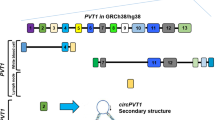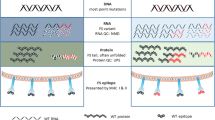Abstract
Objective
The purpose of this study is to identify single nucleotide polymorphisms (SNPs) in the coding region alleles of the X chromosomal LAGE-1 gene, and investigate the frequency of such SNPs in both cancer patients and healthy controls, and thus determine the potential significance of these SNPs with respect to cancer vaccine therapy.
Methods
In this study, different mRNAs transcribed from the LAGE-1 gene were identified by RT-PCR from healthy donors and cancer patients samples.
Results
A new LAGE-1 allele containing three coding region SNPs (69A/G, 317C/G, and 397T/G) were identified. The allele is highly expressed as the LAGE-1a mRNA variant AY679089 in some of the cancer patients. The three SNPs altered the LAGE-1 gene sequence to that of NYESO-1 at both the nucleotide and amino acid level.
Conclusion
There is a high frequency of the LAGE-1 gene allele with SNPs in coding regions in cancer patients. There was a clear relationship between the variant AY679089 and gastric cancer. The SNPs may lead to accelerated progress of poorly differentiated gastric cancer. The SNPs found in these alleles may also alter the immunological characteristics of LAGE-1a and should be taken into account if this antigen is adopted as a cancer vaccine component.



Similar content being viewed by others
References
Aradhya S, Bardaro T, Galgoczy P, Yamagata T, Esposito T, Patlan H, Ciccodicola A, Munnich A, Kenwrick S, Platzer M, D’Urso M, Nelson DL (2001) Multiple pathogenic and benign genomic rearrangements occur at a 35 kb duplication involving the NEMO and LAGE2 genes. Hum Mol Genet 10:2557–2567
Ayyoub M, Mazarguil H, Monsarrat B, Van den Eynde B, Gairin JE (1999) A structure-based approach to designing non-natural peptides that can activate anti-melanoma cytotoxic T cells. J Biol Chem 274:10227–10234
Bai XF, Liu J, Li O, Zheng P, Liu Y (2003) Antigenic drift as a mechanism for tumor evasion of destruction by cytolytic T lymphocytes. J Clin Invest 111:1487–1496
Beck-Engeser GB, Monach PA, Mumberg D, Yang F, Wanderling S, Schreiber K, Espinosa R 3rd, Le Beau MM, Meredith SC, Schreiber H (2001) Point mutation in essential genes with loss or mutation of the second allele: relevance to the retention of tumor-specific antigens. J Exp Med 94:285–300
Biros E, Kohut A, Biros I, Kalina I, Bogyiova E, Stubna J (2002) A link between the p53 germ line polymorphisms and white blood cells apoptosis in lung cancer patients. Lung Cancer 35:231–235
Boon T, van der Bruggen P (1996) Human tumor antigens recognized by T lymphocytes. J Exp Med 183:725–729
Cargill M, Altshuler D, Ireland J, Sklar P, Ardlie K, Patil N, Shaw N, Lane CR, Lim EP, Kalyanaraman N, Nemesh J, Ziaugra L, Friedland L, Rolfe A, Warrington J, Lipshutz R, Daley GQ, Lander ES (1999) Characterization of single-nucleotide polymorphisms in coding regions of human genes. Nat Genet 22:231–238
Davis ID, Chen W, Jackson H, Parente P, Shackleton M, Hopkins W, Chen Q, Dimopoulos N, Luke T, Murphy R, Scott AM, Maraskovsky E, McArthur G, MacGregor D, Sturrock S, Tai TY, Green S, Cuthbertson A, Maher D, Miloradovic L, Mitchell SV, Ritter G, Jungbluth AA, Chen YT, Gnjatic S, Hoffman EW, Old LJ, Cebon JS (2004) Recombinant NY-ESO-1 protein with ISCOMATRIX adjuvant induces broad integrated antibody and CD4(+) and CD8(+) T cell responses in humans. Proc Natl Acad Sci USA 101:10697–10702
Dunn GP, Old LJ, Schreiber RD (2004) Immunobiology of cancer immunosurveillance and immunoediting. Immunity 21:137–148
Dutoit V, Guillaume P, Cerottini JC, Romero P, Valmori D (2002) Dissecting TCR-MHC/peptide complex interactions with A2/peptide multimers incorporating tumor antigen peptide variants: crucial role of interaction kinetics on functional outcomes. Eur J Immunol 32:3285–3293
Gnjatic S, Jager E, Chen W, Altorki NK, Matsuo M, Lee SY, Chen Q, Nagata Y, Atanackovic D, Chen YT, Ritter G, Cebon J, Knuth A, Old LJ (2002) CD8(+) T cell responses against a dominant cryptic HLA-A2 epitope after NY-ESO-1 peptide immunization of cancer patients. Proc Natl Acad Sci USA 99:11813–11818
Gnjatic S, Atanackovic D, Jager E, Matsuo M, Selvakumar A, Altorki NK, Maki RG, Dupont B, Ritter G, Chen YT, Knuth A, Old LJ (2003) Survey of naturally occurring CD4+ T cell responses against NY-ESO-1 in cancer patients: correlation with antibody responses. Proc Natl Acad Sci USA 100:8862–8867
Jager E, Chen Y, Drijfhout JW, Karbach J, Ringhoffer M, Jager D, Arand M, Wada H, Noguchi Y, Stockert E, Old LJ, Knuth A (1998) Simultaneous humoral and cellular immune response against cancer-testis antigen NY-ESO-1: definition of human histocompatibility leukocyte antigen (HLA)-A2-binding peptide epitopes. J Exp Med 187:265–270
Jager E, Gnjatic S, Nagata Y, Stockert E, Jager D, Karbach J, Neumann A, Rieckenberg J, Chen YT, Ritter G, Hoffman E, Arand M, Old LJ, Knuth A (2000) Induction of primary NY-ESO-1 immunity: CD8+ T lymphocyte and antibody responses in peptide-vaccinated patients with NY-ESO-1+ cancers. Proc Natl Acad Sci USA 97:12198–12203
Khong HT, Yang JC, Topalian SL, Sherry RM, Mavroukakis SA, White DE, Rosenberg SA (2004) Immunization of HLA-A*0201 and/or HLA-DPbeta1*04 patients with metastatic melanoma using epitopes from the NY-ESO-1 antigen. J Immunother 27:472–477
Knuth A, Jager D, Jager E (2000) Cancer immunotherapy in clinical oncology. Cancer Chemother Pharmacol 46(Suppl):S46–S51
Korangy F, Ormandy LA, Bleck JS, Klempnauer J, Wilkens L, Manns MP, Greten TF (2004) Spontaneous tumor-specific humoral and cellular immune responses to NY-ESO-1 in hepatocellular carcinoma. Clin Cancer Res 10:4332–4341
Lee JE, Lee SJ, Namkoong SE, Um SJ, Sull JW, Jee SH, You YK, Park JS (2004) Gene-gene and gene-environmental interactions of p53, p21, and IRF-1 polymorphisms in Korean women with cervix cancer. Int J Gynecol Cancer 14:118–125
Lethe B, Lucas S, Michaux L, De Smet C, Godelaine D, Serrano A, De Plaen E, Boon T (1998) LAGE-1, a new gene with tumor specificity. Int J Cancer 76:903–908
Riva A, Kohane IS (2004) A SNP-centric database for the investigation of the human genome. BMC Bioinformatics 5:33
Scanlan MJ, Welt S, Gordon CM, Chen YT, Gure AO, Stockert E, Jungbluth AA, Ritter G, Jager D, Jager E, Knuth A, Old LJ (2002a) Cancer-related serological recognition of human colon cancer: identification of potential diagnostic and immunotherapeutic targets. Cancer Res 62:4041–4047
Scanlan MJ, Simpson AJ, Old LJ (2004) The cancer/testis genes: review, standardization, and commentary. Cancer Immun 4:1
Shang XY, Chen H, Zhang HG, Pang XW, Qiao H, Peng JR, Qin LL, Fei R, Mei MH, Leng XS, Gnjatic S, Ritter G, Simpson AJ, Old LJ, Chen WF (2004) The spontaneous CD8+ T-cell response to HLA-A2-restricted NY-ESO-1b peptide in hepatocellular carcinoma patients. Clin Cancer Res 10:6946–6955
Stockert E, Jager E, Chen YT, Scanlan MJ, Gout I, Karbach J, Arand M, Knuth A, Old LJ (1998) A survey of the humoral immune response of cancer patients to a panel of human tumor antigens. J Exp Med 187:1349–1354
van der Bruggen P, Traversari C, Chomez P, Lurquin C, De Plaen E, Van den Eynde B, Knuth A, Boon T (1991) A gene encoding an antigen recognized by cytolytic T lymphocytes on a human melanoma. Science 254:1643–1647
Wang WW, Spurdle AB, Kolachana P, Bove B, Modan B, Ebbers SM, Suthers G, Tucker MA, Kaufman DJ, Doody MM, Tarone RE, Daly M, Levavi H, Pierce H, Chetrit A, Yechezkel GH, Chenevix-Trench G, Offit K, Godwin AK, Struewing JP (2001) A single nucleotide polymorphism in the 5′ untranslated region of RAD51 and risk of cancer among BRCA1/2 mutation carriers. Cancer Epidemiol Biomarkers Prev 10:955–960
Wang HY, Lee DA, Peng G, Guo Z, Li Y, Kiniwa Y, Shevach EM, Wang RF (2004a) Tumor-specific human CD4+ regulatory T cells and their ligands: implications for immunotherapy. Immunity 20:107–118
Wang Y, Wu X, Zhao AL, Yuan YH, Chen YT, Jungbluth AA, Gnjatic S, Santiago D, Ritter G, Chen WF, Old LJ, Ji JF (2004b) Cancer/testis antigen expression and autologous humoral immunity to NY-ESO-1 in gastric cancer. Cancer Immun 4:11
Wei YQ, Huang MJ, Yang L, Zhao X, Tian L, Lu Y, Shu JM, Lu CJ, Niu T, Kang B, Mao YQ, Liu F, Wen YJ, Lei S, Luo F, Zhou LQ, Peng F, Jiang Y, Liu JY, Zhou H, Wang QR, He QM, Xiao F, Lou YY, Xie XJ, Li Q, Wu Y, Ding ZY, Hu B, Hu M, Zhang W (2001) Therapy of tumors with vaccine based on Xenopus homologous vascular endothelial growth factor as a model antigen. Proc Natl Acad Sci USA 98:11545–11550
Zeng G, Aldridge ME, Wang Y, Pantuck AJ, Wang AY, Liu YX, Han Y, Yuan YH, Robbins PF, Dubinett SM, deKernion JB, Belldegrun AS (2005) Dominant B cell epitope from NY-ESO-1 recognized by sera from a wide spectrum of cancer patients: implications as a potential biomarker. Int J Cancer 114:268–273
Zienolddiny S, Ryberg D, Maggini V, Skaug V, Canzian F, Haugen A (2004) Polymorphisms of the interleukin-1 beta gene are associated with increased risk of non-small cell lung cancer. Int J Cancer 109:353–356
Acknowledgments
This study was supported by Designed Grant of Cancer Research Institute (New York, NY), Hong Kong University of Science and Technology Grant Council, New Star Program of Science technology of the Beijing Science and Technology Committee (H020821370130), the Youth Foundation of Peking Union Medical College Hospital under Grant No. 2005 37A. National Natural Science Foundation of China (no.30600729) and China Medical Board In New York No.06-837.
Author information
Authors and Affiliations
Corresponding author
Additional information
Yi Shao and Zhen-yuan Sun contributed equally to this article.
Rights and permissions
About this article
Cite this article
Shao, Y., Sun, Zy., Sun, Sw. et al. Identification and expression analysis of novel LAGE-1 alleles with single nucleotide polymorphisms in cancer patients. J Cancer Res Clin Oncol 134, 495–502 (2008). https://doi.org/10.1007/s00432-007-0312-z
Received:
Accepted:
Published:
Issue Date:
DOI: https://doi.org/10.1007/s00432-007-0312-z




